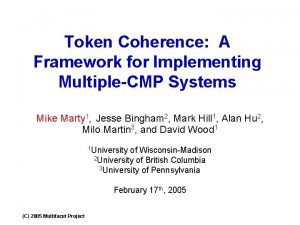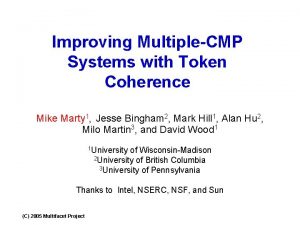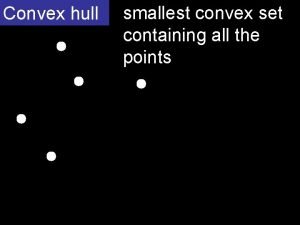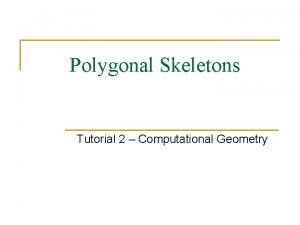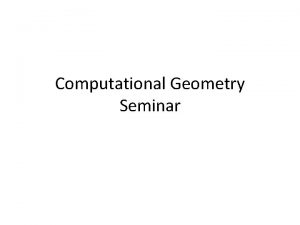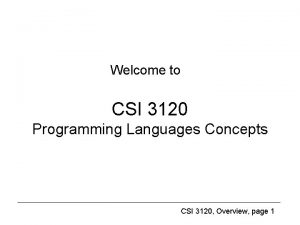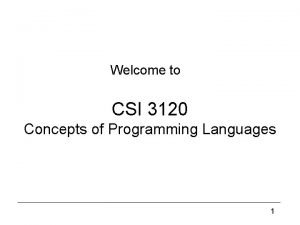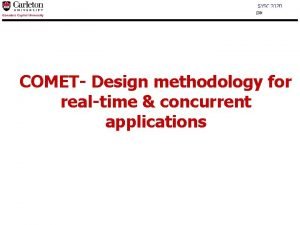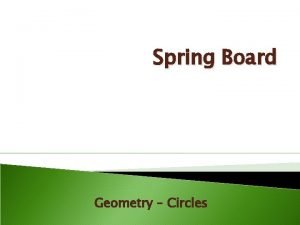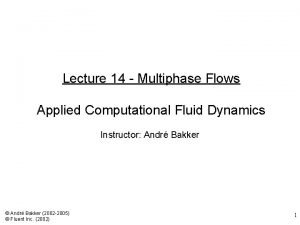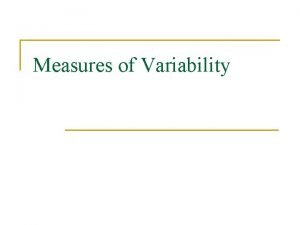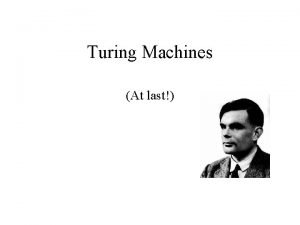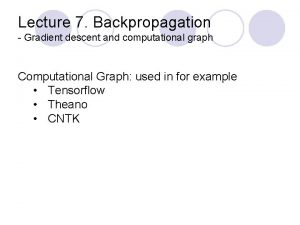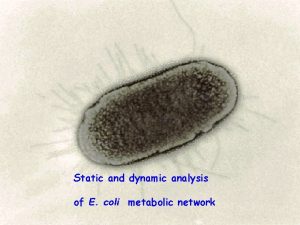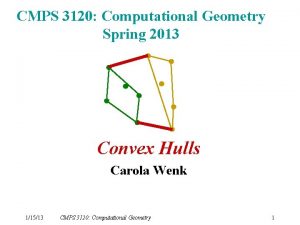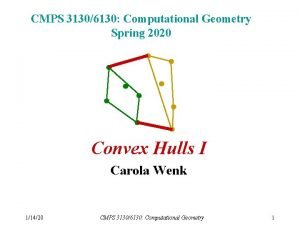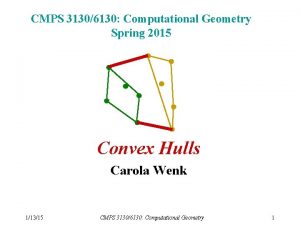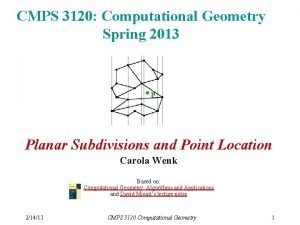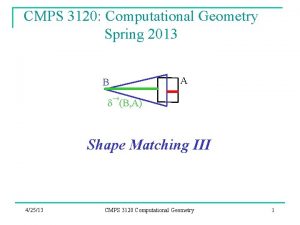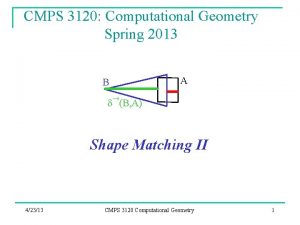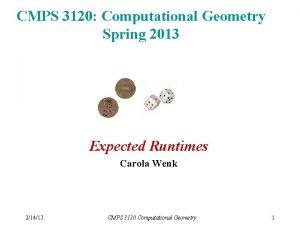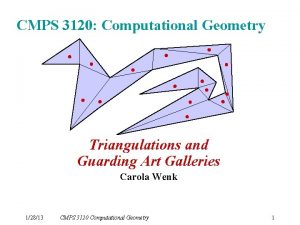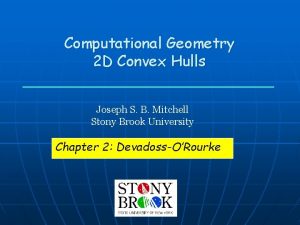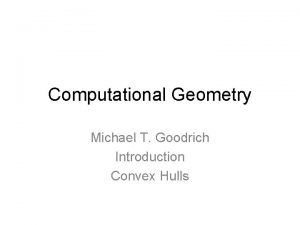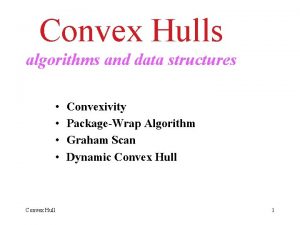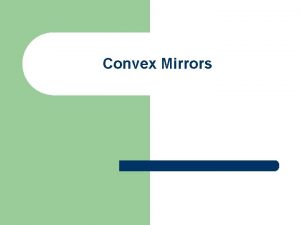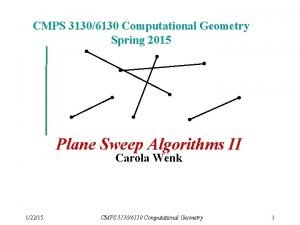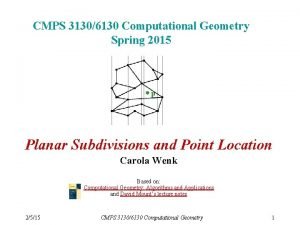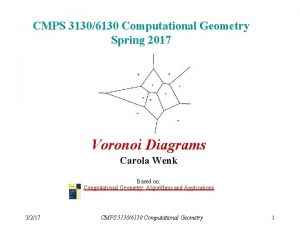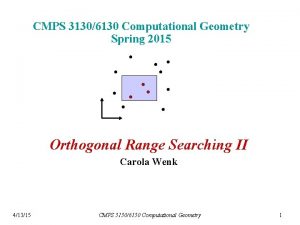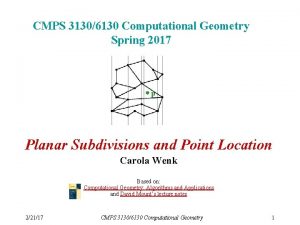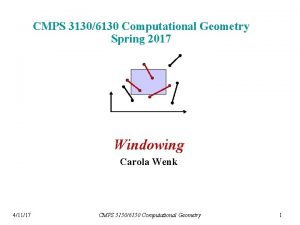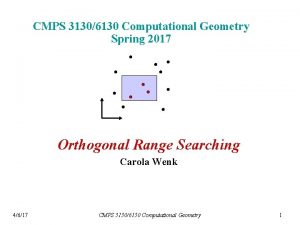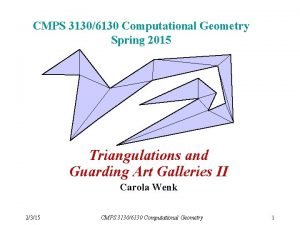CMPS 3120 Computational Geometry Spring 2013 Convex Hulls








































- Slides: 40

CMPS 3120: Computational Geometry Spring 2013 Convex Hulls II Carola Wenk 1/17/13 CMPS 3120: Computational Geometry 1

q 1 q 2 Jarvis’ March (Gift Wrapping) Algorithm Giftwrapping_CH(P): // Compute CH(P) by incrementally inserting points from left to right Input: Point set P R 2 Output: List q 1, q 2, … of vertices in counter-clockwise order around CH(P) q 1 = lexicographically smallest point in P q 2 = point in P with smallest angle to horizontal line through q 1 i=2 do { i++ qi = point with smallest angle to line through qi-2 and qi-1 } while qi ≠ p 1 q 3 • Runtime: O(hn) , where n = |P| and h = #points on CH(P) • Output-sensitive algorithm 1/17/13 CMPS 3120: Computational Geometry 2

Incremental Insertion Algorithm Incremental_CH(P): // Compute CH(P) by incrementally inserting points from left to right Input: Point set P R 2 Output: C=CH(P), described as a list of vertices in counter-clockwise order O(n log n) Sort points in P lexicographically (by x-coordinate, break ties by y-coordinate) O(1) Remove first three points from P and insert them into C in counter-clockwise order around the triangle described by them. n-3 times for all p P // Incrementally add p to hull O(i) Compute the two tangents to p and C O(i) Remove enclosed non-hull points from C, and insert p n 2) , where n = |P| • Runtime: O( i = n i=3 • Really? 1/17/13 CMPS 3120: Computational Geometry 3

Tangent computation vt succ(pi-1) pred(pi-1) pi-1 pi vb upper_tangent(C, pi): // Compute upper tangent to pi and C. Return tangent vertex vt vt = pi-1 while succ(vt) lies above line through pi and v vt = succ(vt) return vt Amortization: Every vertex that is checked during tangent computation is afterwards deleted from the current convex hull C 1/17/13 CMPS 3120: Computational Geometry 4

Incremental Insertion Algorithm Incremental_CH(P): // Compute CH(P) by incrementally inserting points from left to right Input: Point set P R 2 Output: C=CH(P), described as a list of vertices in counter-clockwise order O(n log n) Sort points in P lexicographically (by x-coordinate, break ties by y-coordinate) O(1) Remove first three points from P and insert them into C in counter-clockwise order around the triangle described by them. n-3 times for all p P // Incrementally add p to hull O(1) amort. Compute the two tangents to p and C Remove enclosed non-hull points from C, and insert p O(1) amort. • Runtime: O(n log n + n) = O(n log n), where n = |P| 1/17/13 CMPS 3120: Computational Geometry 5

Convex Hull: Divide & Conquer · Preprocessing: sort the points by xcoordinate · Divide the set of points into two sets A and B: · A contains the left n/2 points, · B contains the right n/2 points ·Recursively compute the convex hull of A ·Recursively compute the convex hull A B of B · Merge the two convex hulls 1/17/13 CMPS 3120: Computational Geometry 6

Merging · Find upper and lower tangent · With those tangents the convex hull of A B can be computed from the convex hulls of A and the convex hull of B in O(n) linear time A 1/17/13 CMPS 3120: Computational Geometry B 7

Finding the lower tangent 3 a = rightmost point of A b = leftmost point of B 4=b 4 while T=ab not lower tangent to both convex hulls of A and B do{ while T not lower tangent to convex hull of A do{ a=a-1 } while T not lower tangent to convex hull of B do{ b=b+1 left turn } } check with orientation test 1/17/13 CMPS 3120: Computational Geometry 3 5 2 5 a=2 1 6 7 0 0 A 1 B right turn 8

Convex Hull: Runtime · Preprocessing: sort the points by xcoordinate · Divide the set of points into two sets A and B: O(n log n) just once O(1) · A contains the left n/2 points, · B contains the right n/2 points ·Recursively compute the convex hull T(n/2) · Merge the two convex hulls O(n) of A of B 1/17/13 CMPS 3120: Computational Geometry 9

Convex Hull: Runtime · Runtime Recurrence: T(n) = 2 T(n/2) + cn · Solves to T(n) = (n log n) 1/17/13 CMPS 3120: Computational Geometry 10

Recurrence (Just like merge sort recurrence) 1. Divide: Divide set of points in half. 2. Conquer: Recursively compute convex hulls of 2 halves. 3. Combine: Linear-time merge. T(n) = 2 T(n/2) + O(n) work dividing # subproblems subproblem size and combining 1/17/13 CMPS 3120: Computational Geometry 11

Recurrence (cont’d) T(n) = (1) if n = 1; 2 T(n/2) + (n) if n > 1. • How do we solve T(n)? I. e. , how do we find out if it is O(n) or O(n 2) or …? 1/17/13 CMPS 3120: Computational Geometry 12

Recursion tree Solve T(n) = 2 T(n/2) + dn, where d > 0 is constant. 1/17/13 CMPS 3120: Computational Geometry 13

Recursion tree Solve T(n) = 2 T(n/2) + dn, where d > 0 is constant. T(n) 1/17/13 CMPS 3120: Computational Geometry 14

Recursion tree Solve T(n) = 2 T(n/2) + dn, where d > 0 is constant. dn T(n/2) 1/17/13 CMPS 3120: Computational Geometry T(n/2) 15

Recursion tree Solve T(n) = 2 T(n/2) + dn, where d > 0 is constant. dn dn/2 T(n/4) 1/17/13 T(n/4) CMPS 3120: Computational Geometry dn/2 T(n/4) 16

Recursion tree Solve T(n) = 2 T(n/2) + dn, where d > 0 is constant. dn dn/2 dn/4 … dn/4 (1) 1/17/13 CMPS 3120: Computational Geometry 17

Recursion tree Solve T(n) = 2 T(n/2) + dn, where d > 0 is constant. dn dn/2 dn/4 … h = log n dn/4 (1) 1/17/13 CMPS 3120: Computational Geometry 18

Recursion tree Solve T(n) = 2 T(n/2) + dn, where d > 0 is constant. dn dn dn/2 dn/4 … h = log n dn/4 (1) 1/17/13 CMPS 3120: Computational Geometry 19

Recursion tree Solve T(n) = 2 T(n/2) + dn, where d > 0 is constant. dn dn dn/2 dn/4 … h = log n dn/4 dn (1) 1/17/13 CMPS 3120: Computational Geometry 20

Recursion tree Solve T(n) = 2 T(n/2) + dn, where d > 0 is constant. dn dn dn/4 … h = log n dn/4 dn … dn/2 (1) 1/17/13 CMPS 3120: Computational Geometry 21

Recursion tree Solve T(n) = 2 T(n/2) + dn, where d > 0 is constant. dn dn dn/2 dn/4 (1) 1/17/13 dn/4 dn … … h = log n dn/4 dn #leaves = n CMPS 3120: Computational Geometry (n) 22

Recursion tree Solve T(n) = 2 T(n/2) + dn, where d > 0 is constant. dn dn dn/2 dn/4 (1) dn/4 dn … … h = log n dn/4 dn #leaves = n (n) Total (n log n) 1/17/13 CMPS 3120: Computational Geometry 23

The divide-and-conquer design paradigm 1. Divide the problem (instance) into subproblems. a subproblems, each of size n/b 2. Conquer the subproblems by solving them recursively. 3. Combine subproblem solutions. Runtime is f(n) 1/17/13 CMPS 3120: Computational Geometry 24

Master theorem T(n) = a T(n/b) + f (n) , where a ³ 1, b > 1, and f is asymptotically positive. CASE 1: f (n) = O(nlogba – e) T(n) = (nlogba). CASE 2: f (n) = (nlogba logkn) T(n) = (nlogba logk+1 n). CASE 3: f (n) = (nlogba + e) and a f (n/b) c f (n) T(n) = ( f (n)). Convex hull: a = 2, b = 2 nlogba = n CASE 2 (k = 0) T(n) = (n log n). 1/17/13 CMPS 3120: Computational Geometry 25

Graham’s Scan Another incremental algorithm – Compute solution by incrementally adding points – Add points in which order? • Sorted by x-coordinate • But convex hulls are cyclically ordered Break convex hull in upper and lower part upper convex hull UCH(P) lower convex hull LCH(P) 1/17/13 CMPS 3120: Computational Geometry 26

Graham’s LCH Algorithm Grahams_LCH(P): // Incrementally compute the lower convex hull of P Input: Point set P R 2 Output: A list L of vertices describing LCH(P) in counter-clockwise order O(n log n) O(n) Sort P in increasing order by x-coordinate P = {p 1, …, pn} L = {p 2, p 1} for i=3 to n while |L|>=2 and orientation(L. second(), L. first(), pi, ) <= 0 // no left turn delete first element from L Append pi to the front of L • Each element is appended only once, and hence only deleted at most once the for-loop takes O(n) time • O(n log n) time total 1/17/13 CMPS 3120: Computational Geometry 27

Lower Bound • Comparison-based sorting of n elements takes (n log n) time. • How can we use this lower bound to show a lower bound for the computation of the convex hull of n points in R 2? 1/17/13 CMPS 3120: Computational Geometry 28

Decision-tree model A decision tree models the execution of any comparison sorting algorithm: • One tree per input size n. • The tree contains all possible comparisons (= if-branches) that could be executed for any input of size n. • The tree contains all comparisons along all possible instruction traces (= control flows) for all inputs of size n. • For one input, only one path to a leaf is executed. • Running time = length of the path taken. • Worst-case running time = height of tree. 29

Decision-tree for insertion sort Sort áa 1, a 2, a 3ñ a 1 a 2 a 3 i j a 1: a 2 < insert a 3 < a 2: a 3 a 1 a 2 a 3 < ³ a 1: a 3 a 1 a 3 a 2 a 1 a 2 a 3 j i ³ a 3 a 1 a 2 ³ < a 1 a 2 a 3 insert a 2 i j a 1: a 3 a 2 a 1 a 3 < a 2 a 1 a 3 insert a 3 ³ i j a 2: a 3 a 2 a 3 a 1 a 2 a 1 a 3 j i ³ a 3 a 2 a 1 Each internal node is labeled ai: aj for i, j {1, 2, …, n}. • The left subtree shows subsequent comparisons if ai < aj. • The right subtree shows subsequent comparisons if ai ³ aj. 30

Decision-tree for insertion sort Sort áa 1, a 2, a 3ñ = <9, 4, 6> a 1 a 2 a 3 i j a 1: a 2 < insert a 3 < a 2: a 3 a 1 a 2 a 3 < ³ a 1: a 3 a 1 a 3 a 2 a 1 a 2 a 3 j i ³ a 3 a 1 a 2 ³ < a 1 a 2 a 3 insert a 2 i j a 1: a 3 a 2 a 1 a 3 < a 2 a 1 a 3 insert a 3 ³ i j a 2: a 3 a 2 a 3 a 1 a 2 a 1 a 3 j i ³ a 3 a 2 a 1 Each internal node is labeled ai: aj for i, j {1, 2, …, n}. • The left subtree shows subsequent comparisons if ai < aj. • The right subtree shows subsequent comparisons if ai ³ aj. 31

Decision-tree for insertion sort Sort áa 1, a 2, a 3ñ = <9, 4, 6> a 1 a 2 a 3 i j a 1: a 2 < insert a 3 < a 2: a 3 a 1 a 2 a 3 < ³ a 1: a 3 a 1 a 3 a 2 a 1 a 2 a 3 j i ³ a 3 a 1 a 2 a 1 a 2 a 3 insert a 2 i j 9³ 4 < a 1: a 3 a 2 a 1 a 3 < a 2 a 1 a 3 insert a 3 ³ i j a 2: a 3 a 2 a 3 a 1 a 2 a 1 a 3 j i ³ a 3 a 2 a 1 Each internal node is labeled ai: aj for i, j {1, 2, …, n}. • The left subtree shows subsequent comparisons if ai < aj. • The right subtree shows subsequent comparisons if ai ³ aj. 32

Decision-tree for insertion sort Sort áa 1, a 2, a 3ñ = <9, 4, 6> a 1 a 2 a 3 i j a 1: a 2 < insert a 3 < a 2: a 3 a 1 a 2 a 3 < ³ a 1: a 3 a 1 a 3 a 2 a 1 a 2 a 3 j i ³ a 3 a 1 a 2 ³ < a 1 a 2 a 3 insert a 2 i j a 1: a 3 a 2 a 1 a 3 < a 2 a 1 a 3 insert a 3 i j 9³ 6 a 2: a 3 a 2 a 3 a 1 a 2 a 1 a 3 j i ³ a 3 a 2 a 1 Each internal node is labeled ai: aj for i, j {1, 2, …, n}. • The left subtree shows subsequent comparisons if ai < aj. • The right subtree shows subsequent comparisons if ai ³ aj. 33

Decision-tree for insertion sort Sort áa 1, a 2, a 3ñ = <9, 4, 6> a 1: a 2 < insert a 3 a 1 a 2 a 3 i j < a 2: a 3 a 1 a 2 a 3 < ³ a 1: a 3 a 1 a 3 a 2 a 1 a 2 a 3 j i ³ a 3 a 1 a 2 ³ < a 1 a 2 a 3 insert a 2 i j a 1: a 3 a 2 a 1 a 3 4<6 ³ a 2 a 1 a 3 insert a 3 i j a 2: a 3 a 2 a 3 a 1 a 2 a 1 a 3 j i ³ a 3 a 2 a 1 Each internal node is labeled ai: aj for i, j {1, 2, …, n}. • The left subtree shows subsequent comparisons if ai < aj. • The right subtree shows subsequent comparisons if ai ³ aj. 34

Decision-tree for insertion sort Sort áa 1, a 2, a 3ñ = <9, 4, 6> a 1: a 2 < insert a 3 a 1 a 2 a 3 i j < a 2: a 3 a 1 a 2 a 3 < ³ a 1: a 3 a 1 a 3 a 2 a 1 a 2 a 3 j i ³ a 3 a 1 a 2 ³ < a 1 a 2 a 3 insert a 2 i j a 1: a 3 a 2 a 1 a 3 < ³ a 2 a 1 a 3 insert a 3 i j a 2: a 3 a 2 a 3 a 1 a 2 a 1 a 3 j i ³ a 3 a 2 a 1 4<6 9 Each internal node is labeled ai: aj for i, j {1, 2, …, n}. • The left subtree shows subsequent comparisons if ai < aj. • The right subtree shows subsequent comparisons if ai ³ aj. 35

Decision-tree for insertion sort Sort áa 1, a 2, a 3ñ = <9, 4, 6> a 1 a 2 a 3 i j a 1: a 2 < insert a 3 < a 2: a 3 a 1 a 2 a 3 < ³ a 1: a 3 a 1 a 3 a 2 a 1 a 2 a 3 j i ³ a 3 a 1 a 2 ³ < a 1 a 2 a 3 insert a 2 i j a 1: a 3 a 2 a 1 a 3 < ³ a 2 a 1 a 3 insert a 3 i j a 2: a 3 a 2 a 3 a 1 4<6 9 a 2 a 1 a 3 j i ³ a 3 a 2 a 1 Each leaf contains a permutation áp(1), p(2), …, p(n)ñ to indicate that the ordering ap(1) ap(2) . . . ap(n) has been established. 36

Lower bound for comparison sorting Theorem. Any decision tree that can sort n elements must have height (n log n). Proof. The tree must contain ³ n! leaves, since there are n! possible permutations. A height-h binary tree has 2 h leaves. Thus, n! 2 h. h ³ log(n!) (log is mono. increasing) ³ log ((n/2) = n/2 log n/2 h (n log n). 37

Lower Bound • Comparison-based sorting of n elements takes (n log n) time. • How can we use this lower bound to show a lower bound for the computation of the convex hull of n points in R 2? • Devise a sorting algorithm which uses the convex hull and otherwise only linear-time operations Since this is a comparison-based sorting algorithm, the lower bound (n log n) applies Since all other operations need linear time, the convex hull algorithm has to take (n log n) time 1/17/13 CMPS 3120: Computational Geometry 38

CH_Sort Algorithm CH_Sort(S): /* Sorts a set of numbers using a convex hull algorithm. Converts numbers to points, runs CH, converts back to sorted sequence. */ Input: Set of numbers S R Output: A list L of of numbers in S sorted in increasing order P= for each s S insert (s, s 2) into P L’ = CH(P) // compute convex hull Find point p’ P with minimum x-coordinate for each p=(px, py) L’, starting with p’, add px into L return L 1/17/13 CMPS 3120: Computational Geometry s 2 -4 -2 1 4 5 39 s

Convex Hull Summary • • • Brute force algorithm: Jarvis’ march (gift wrapping): Incremental insertion: Divide-and-conquer: Graham’s scan: Lower bound: 1/17/13 CMPS 3120: Computational Geometry O(n 3) O(nh) O(n log n) 40
 Hull's landing
Hull's landing Cmps token
Cmps token Cmps token
Cmps token Hull drive reduction theory
Hull drive reduction theory Pinwheels and polygons
Pinwheels and polygons Convex hull is the smallest convex set
Convex hull is the smallest convex set Straight skeleton
Straight skeleton Computational geometry
Computational geometry Sysc 4120
Sysc 4120 Csi 3120
Csi 3120 Csi3120
Csi3120 Sysc 3120
Sysc 3120 Kim ki duk spring summer fall winter
Kim ki duk spring summer fall winter Four seasons months
Four seasons months Half circle formula
Half circle formula 4 electron domains 2 lone pairs
4 electron domains 2 lone pairs Molecular geometry and bonding theories
Molecular geometry and bonding theories Theory of structures
Theory of structures Hms research computing
Hms research computing Computational philology
Computational philology Computational sustainability subjects
Computational sustainability subjects Computational fluid dynamics
Computational fluid dynamics Computational fluid dynamics
Computational fluid dynamics Standard deviation computational formula
Standard deviation computational formula Computational creativity market trends
Computational creativity market trends Computational engineering and physical modeling
Computational engineering and physical modeling Slo computational thinking
Slo computational thinking Aima ai slides
Aima ai slides Computational diagnostics
Computational diagnostics Computational methods in plasma physics
Computational methods in plasma physics Universal computational device
Universal computational device Computational graph backpropagation
Computational graph backpropagation Computational photography uiuc
Computational photography uiuc Www.aka.ms/addcomputer
Www.aka.ms/addcomputer Computational sustainability scope
Computational sustainability scope Cmu pitt computational biology
Cmu pitt computational biology Computational approaches
Computational approaches Grc computational chemistry
Grc computational chemistry What is computational fluency
What is computational fluency Tu bergakademie freiberg computational materials science
Tu bergakademie freiberg computational materials science Computational photography uiuc
Computational photography uiuc

